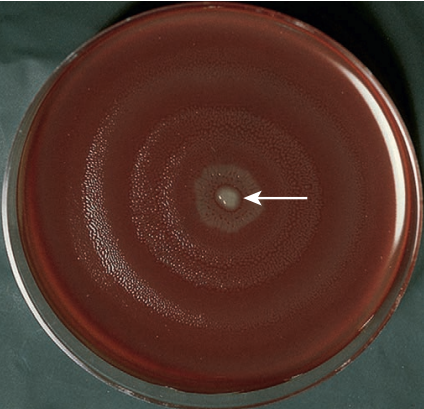iMLS-MICROBIOLOGY
- Description
- Curriculum
- Reviews
-
1SPECIMEN COLLECTION AND PROCESSING
-
2RECORDED LECTURE - SPECIMEN HANDLING
A major goal of the microbiology laboratory is to aid in the diagnosis of infectious diseases. Appropriate specimen selection, collection, and transportation are critical if laboratory results are used to provide information that establishes a diagnosis and successful treatment.
This lesson introduces the concepts of specimen collection and processing. The steps to ensuring specimen quality and the steps that follow specimen receipt in completing the processing for microbiology workup.
-
3COLONY MORPHOLOGY FOR THE IDENTIFICATION OF MICROORGANISMS
-
4RECORDED LECTURE - COLONY MORPHOLOGY IDENTIFICATION
Generally, the colonial morphology is observed after 18 to 24 hours of incubation. Many specimens, such as sputum and wounds that arrive in the clinical laboratory, are plated on various culture media such as BAP, CHOC, and MAC. Each type of agar plate is examined in relationship to the other.
-
5BIOCHEMICAL IDENTIFICATION OF GRAM-NEGATIVE BACTERIA
-
6RECORDED LECTURE - BIOCHEMICAL IDENTIFICATION OF GRAM NEGATIVE BACTERIA
Among bacteria, there is great diversity in the ability to use carbohydrates; however, determining lactose utilization is the most important.
Lactose degradation can be used to differentiate bacterial species able to ferment lactose (lactose fermenters [LFs]) from species that are NLFs.
-
7ANTIMICROBIAL SUSCEPTIBILITY TESTING
-
8RECORDED - ANTIMICROBIAL SUSCEPTIBILITY TESTING
Antimicrobial susceptibility testing (AST) is performed on bacteria isolated from clinical specimens to determine which antimicrobial agents might be effective in treating infections caused by the bacteria. Only bacteria that are likely to be contributing to an infection should be tested.
Susceptibility testing is usually performed by a disk diffusion or dilution (minimal inhibitory concentration) method.
-
9STAPHYLOCOCCACEAE
-
10RECORDED LECTURE - STAPHYLOCOCCACEAE
-
11STREPTOCOCCACEAE AND OTHER RELATED ORGANISMS
-
12RECORDED LECTURE - STREPTOCOCCUS PART II
-
13ENTEROBACTERIACEAE
-
14RECORDED LECTURE - ENTEROBACTERIACEAE PART I
-
15RECORDED LECTURE - ENTEROBACTERIACEAE PART II
-
16NEISSERIACEAE AND MORAXELLACEAE
-
17RECORDED LECTURE - NEISSERIACEAE PART I
-
18RECORDED LECTURE- NEISSERIACEAE PART II
-
19HAEMOPHILUS AND OTHER FASTIDIOUS GRAM-NEGATIVE SPECIES
-
20OTHER FASTIDIOUS GRAM-NEGATIVE BACILLI, BORDETELLA AND LEGIONELLA SPP.
-
21RECORDED LECTURE - OTHER FASTIDIUS GRAM NEGATIVE BACILLI
-
22VIBRIO, AEROMONAS, PLESIOMONAS, AND CAMPYLOBACTER SPECIES
-
23RECORDED LECTURE - VIBRIONACEAE PART I
This lesson discusses agents of diarrheal diseases and other infections caused by species of Vibrio, Aeromonas, Plesiomonas, Campylobacter, and Helicobacter.
This group of organisms is important because some of them, the Vibrio spp. in particular, have been associated with large epidemics and pandemics. In addition, Campylobacter spp. infection may play a role in Guillain-Barré syndrome (GBS), and Helicobacter pylori can cause ulcers and has been linked to gastric carcinoma.
-
24RECORDED LECTURE - VIBRIONACEAE PART II
This lesson discusses agents of diarrheal diseases and other infections caused by species of Vibrio, Aeromonas, Plesiomonas, Campylobacter, and Helicobacter. This group of organisms is important because some of them, the Vibrio spp. in particular, have been associated with large epidemics and pandemics. In addition, Campylobacter spp. infection may play a role in Guillain-Barré syndrome (GBS), and Helicobacter pylori can cause ulcers and has been linked to gastric carcinoma.
-
25NONFERMENTING GRAM-NEGATIVE BACILLI
-
26RECORDED LECTURE - NON-FERMENTERS PART I
Non-fermenting gram-negative bacilli are grouped together because they fail to acidify oxidative-fermentative (OF) media when it is overlaid with mineral oil or fail to acidify triple sugar iron agar (TSIA) butts.
They prefer and grow much better in anaerobic environment; some do not grow in an anaerobic environment at all.
Some oxidize carbohydrates for energy they are referred to as oxidizers. Others do not break down carbohydrates at all; they are referred to as nonoxidizers or asaccharolytic. The are oxidase positive that differentiates them from the Enterobacteriaceae (except Plesiomonas sp.)
-
27RECORDED LECTURE - NONFERMENTERS PART I
Non-fermenting gram-negative bacilli are grouped together because they fail to acidify oxidative-fermentative (OF) media when it is overlaid with mineral oil or fail to acidify triple sugar iron agar (TSIA) butts. They prefer and grow much better in anaerobic environment; some do not grow in an anaerobic environment at all. Some oxidize carbohydrates for energy they are referred to as oxidizers. Others do not break down carbohydrates at all; they are referred to as nonoxidizers or asaccharolytic. The are oxidase positive that differentiates them from the Enterobacteriaceae (except Plesiomonas sp.)
-
28ANAEROBES OF CLINICAL IMPORTANCE
-
29RECORDED LECTURE- ANAEROBES PART I
Anaerobic bacteria are clinically important because they play a role in serious, often fatal, infections and intoxications. They are involved in infectious processes in almost any organ or tissue of the body and consequently can be recovered from most clinical specimens
-
30RECORDED LECTURE- ANAEROBES PART II
Specimen must be transported and processed as rapidly as possible and with minimum exposure to oxygen. It is important to avoid shocking the anaerobes by exposing them to oxygen or permitting them to dry out. In addition, the specimens should not be refrigerated and, the amount of time they remain at RT should be minimized.
-
31THE SPIROCHETES
-
32RECORDED LECTURE- THE SPIROCHETES
The order Spirochaetales contains two families: Leptospiraceae and Spirochaetaceae.
The family Leptospiraceae contains the genus Leptospira, and the family Spirochaetaceae contains Borrelia and Treponema.
These three genera include the causative agents of important human diseases such as syphilis, zoonoses such as leptospirosis, and vector-borne diseases such as Lyme borreliosis or Lyme disease and relapsing fever.
The spirochetes are slender, flexuous, helically shaped, 0.1 to 0.5 µm wide and 5 to 20 µm long, with one or more complete turns in the helix.
-
33THE SPIROCHETES PRACTICE QUESTIONS
-
34CHLAMYDIA, RICKETTSIA, AND SIMILAR ORGANISMS
-
35RECORDED LECTURE - CHLAMYDIA AND RICKETTSIA
-
36MYCOPLASMA AND UREAPLASMA
Mycoplasmas are the smallest self-replicating organisms in nature.
-
37RECORDED LECTURE-MYCOPLASMA AND UREAPLASMA
Mollicutes are generally slow-growing, highly fastidious, facultative anaerobes requiring complex media containing cholesterol and fatty acids for growth; important exceptions include aerobic M. pneumoniae and the more rapidly growing Mycoplasma hominis.
The mollicutes produce small colonies. Mycoplasma spp. often grow embedded beneath the surface of solid media; therefore, transferring colonies with a loop is ineffective.
On solid media, some species (e.g., M. hominis) form colonies with slightly raised centers giving the classic fried egg appearance
-
38MTB AND NTM LESSON 1
MTB and Mycobacterium leprae, the causative agents of tuberculosis (TB) and Hansen disease (leprosy), respectively.
-
39RECORDED- LECTURE MTB PARTI
Mycobacteria are slender, slightly curved or straight, rod-shaped organisms. They are nonmotile and do not form spores. The cell wall has extremely high lipid content; thus, mycobacterial cells resist staining with Gram stain, at RT. Mycobacteria take up dye with increased staining time or application of heat but resist decolorization with acid-ethanol. This characteristic is referred to as “acid fastness”— hence, the term AFB.
Mycobacteria are strictly aerobic, but increased CO2 will enhance the growth of some species. Most pathogenic mycobacteria require 2 to 6 weeks of incubation on complex media at specific optimal temperatures. The rapidly growing species generally grow on simple media in 2 to 3 days at temperatures of 20°C to 40°C. M. leprae, fails to grow in vitro.
-
40RECORDED LECTURE - NTM
-
41MTB AND NTM LESSON 2 - LABORATORY DIAGNOSIS
Rate of growth, colony morphology, pigmentation, nutritional requirements, optimal incubation temperature, and biochemical test results; broth-based culture systems and species-specific nucleic acid probes (PCR) and HPLC are used to identify mycobacteria.
-
42RECORDED LECTURE - MTB LAB DIAGNOSIS
-
43RECORDED LECTURE - MTB LAB IDENTIFICATION
-
44MTB & NTM PRACTICE QUESTIONS
-
45CLINICAL MYCOLOGY - INTRODUCTION
-
46CLINICAL MYCOLOGY
Mycoses (singular, mycosis) are diseases caused by fungi. Fungal disease is categorized based on the site of the infection—superficial, cutaneous, subcutaneous, and systemic mycoses.
-
47RECORDED LECTURE - MYCOLOGY PART I
Fungi constitute an extremely diverse group of organisms and are classified as molds or yeasts. Yeasts are single vegetative cells that typically form a smooth, creamy, bacterial-like colony without aerial hyphae, and reproduce by budding or fission. Most molds have a fuzzy or woolly appearance because of the formation of mycelia. The mycelia are made up of many long strands of tube-like structures called hyphae, which are either aerial or vegetative.
-
48RECORDED LECTURE - MYCOLOGY II
-
49RECORDED LECTURE - MYCOLOGY PART III
-
50LABORATORY DIAGNOSIS OF FUNGI
-
51RECORDED LECTURE - LAB DIAGNOSIS OF FUNGI
-
52THE PROTOZOA
-
53RECORDED LECTURE - PROTOZOLOGY PART I
E. histolytica and E. dispar are morphologically identical organisms that differ in their effects on the host. Recently, Entamoeba moshkovkii, has been identified as belonging to this complex. E. dispar is considered a nonpathogenic E. histolytica, whereas the pathogenic organism remained E. histolytic and E. moshkovkii is thought to be a freeliving organism
-
54RECORDED LECTURE - PROTOZOLOGY PART II
Free-living, thermotolerant amebae found in soil and water usually feed on bacteria in the environment but are known to be capable of causing human disease. They are able to gain access to the CNS by inhalation into the upper respiratory tract followed by penetration of the nasal mucosa, which allows them to travel along the olfactory nerve to the brain, or by hematogenous spread from the lungs or skin lesions. These infections are very difficult to diagnose and treat and are associated with a high mortality rate.
-
55THE PHYLUM APICOMPLEXA
-
56RECORDED LECTURE - APICOMPLEXA PART I
Plasmodium spp., which cause malaria, remain endemic throughout the world in tropical and subtropical countries. Plasmodium vivax, Plasmodium ovale, Plasmodium malariae, and Plasmodium falciparum are the causative agents of human malaria. In general, infections caused by P. vivax, P. ovale, and P. malariae are less severe than those caused by P. falciparum. A fifth species, Plasmodium knowlesi, which causes malaria in the macaque monkey, has also been implicated in cases of zoonotic human malaria in Malaysia and the Philippines.
-
57RECORDED LECTURE - APICOMPLEXA PART II
Babesiosis is a zoonotic intraerythrocytic infection transmitted by the bite of a tick. Although Babesia microti and B. Babesia hominis, have been reported to infect humans, B. microti is the most common. The hard tick (Ixodes spp.) serves as the vector, and white-footed mice and white-tailed deer are the reservoirs. There also have been simultaneous transmission of B. microti and Borrelia burgdorferi (the causative agent of Lyme disease) because these two organisms use the same tick vector.
-
58DIAGNOSTIC HELMONTHOLOGY PART 1
-
59RECORDED LECTURE - HELMINTHOLOGY PART I
Helminth infections in humans are caused by flukes, tapeworms, or roundworms. Humans become infected by directly ingesting eggs (ova), by ingesting larvae in an intermediate host, or through direct larval penetration of the skin. The pathology and severity of infection are related to the number of adults present, referred to as the worm burden. Most of the parasites inhabit the intestinal tract, but species also infect the liver, lungs, lymphatics, and blood vessels.
-
60DIAGNOSTIC HELMINTHOLOGY PART 2
-
61RECORDED LECTURE - HELMINTHOLOGY PART II
Human roundworms include those that infect the intestinal tract and blood and tissue. These organisms are transmitted by the ingestion of the embryonated egg or by direct penetration of the skin by larvae in the soil, or they may require an insect vector. Roundworms are characterized by the presence of two sexes and a life cycle that may involve larval migration throughout the body. The adults obtain nourishment by absorbing nutrients from partly digested intestinal contents or by sucking blood. Patients may be asymptomatic or symptomatic; the severity of the symptoms is related to the worm burden, host’s nutritional status and age, and duration of infection. Most roundworm infections can be treated with oral albendazole or mebendazole.
-
62GENERAL PARASITOLOGY LABORATORY TECHNIQUES
-
63RECORDED LECTURE - PARASITOLOGY TECHS
Formalin can be used when a wet mount or concentration procedure (sedimentation or flotation) will be performed. The fixative sodium acetate–acetic acid–formalin (SAF) can be used for the preservation of fecal specimens when concentration procedures and permanent stains will be used. Vials of merthiolate-iodine-formalin (MIF) can also be used to preserve trophozoites, cysts, larvae, and helminth eggs for wet mount or concentration procedures. This preservative, however, is not routinely used for permanently stained smears.








